The Wichita Indians (original) (raw)
Your name here as sponsor of this page
The Wichita Indians
by Rebecca Brush
Back to the Texas Indians home page

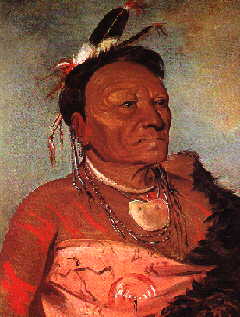
Wee-Ta-Ra-Sha-Ro, Head Chief of the Wichita. Painted by George Catlin in 1834
![]() PAYPAL Support Texas Indians. Even $1.00 helps. It costs to keep things going.
PAYPAL Support Texas Indians. Even $1.00 helps. It costs to keep things going.
The first white men to ever see and record a meeting with the Wichita were Coronado and the men of his expedition. Do you know who Coronado is? Francisco Vazques de Coronado was a Spanish explorer. He explored the American Southwest in the early 1500s looking for riches. Coronado came across the Wichita in 1541 in the Great Bend area of the Arkansas River in what is now south-central Kansas. That was a long time ago--over 450 years. Coronado says of these people: "There are not more than twenty-five towns, with straw houses, in it, nor any more in all the rest of the country that I have seen and learned about . . . All they have is the tanned skins of the cattle they kill, for the herds are near where they live, at quite a large river. They eat meat raw like the Querechos [the Apache] and Teyas [the Jumano]. They are enemies of one another...These people of Quivira have the advantage over the others in their houses and in growing of maize ." From Coronado s description we can find out some very important things about the Wichita. For example, what did we learn of the houses they lived in? Can you picture them? What are the cattle they hunted, ate raw, and tanned the skins of? Did they live totally off of the meat they hunted? Can you picture the kinds of clothes they wore? What kind of neighbors did they have? Could they travel to visit friends in other towns like we do? What was the name of the town they lived in? Were they like other people living in the area? The written accounts of early explorers can tell us a whole bunch about how the native people lived. Don t you think so?
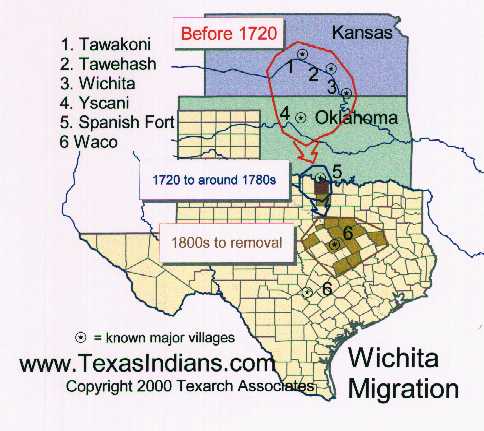
The Wichita are called a tribe, but this is not accurate. There was a proper Wichita tribe with a chief and subchief. Then there were independent subtribes or bands who spoke Wichita and shared the Wichita culture. The tribes called the Wacos and the Tawakonis, the Taovayas, the Tawehash, the Yscani and the Kichai are not tribes at all. They are all bands, bands that are part of the Wichita culture and lived the Wichita lifestyle. If you are confused by all this tribe and band stuff, try the Read Me First page. It explains it all.
What was the Wichita culture? Well, they spoke a language called, surprisingly, Wichita. They are part of a larger cultural group call Caddoan. As a matter of fact, the people who study languages (called linguists) tell us that the Wichita language is one of three different Plains Caddoan languages. The other two Plains Caddoan languages are Pawnee and Kichai. Before the Wichita came to Texas, they lived a semisedentary lifestyle. This means they had farms and villages, but they moved around a little, also. From spring until fall they lived a village life and grew maize, pumpkins, squash, beans and even planted plum trees. And get this; even though they lived near several rivers, the Wichita did not eat fish. In the fall until spring, the Wichita would close up their villages and migrate west to go on a buffalo hunt. Then, in the spring they would return to the village and plant crops again.
While they were in the village, the Wichita lived in grass houses. These houses were made of forked cedar poles. The poles, which were very sturdy, were covered by dried grasses. You may think that this kind of house is not very good. However, these houses were very well made and lasted for many years.
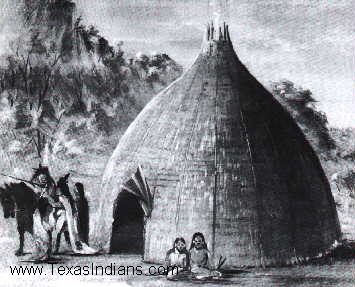
A Wichita grass house. Painted by George Catlin in 1834
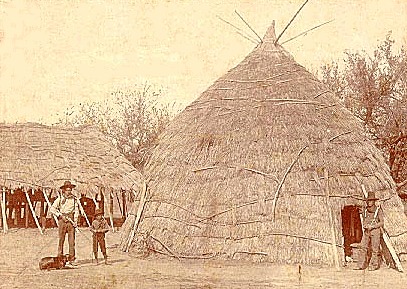
A Wichita grass hut around 1890. Notice the thatched shelter behind the round hut. This is probably a summer house.
They were big, too. Early explorers have described them as being 15 to 30 feet across. [Ed. Note. Look in the Caddoan page to find pictures of these kind of houses.] The houses were shaped like giant cones. Each house had 10 to 12 beds in it. In the center of the roof was a small hole to let out the smoke from the fire which was always placed in the middle of the house floor. There was also a kitchen in these houses. Not like the ones we have today, of course, but it was a hollowed out tree trunk that was used to grind corn and prepare meals. When the Wichita went on their winter buffalo hunts they lived in tepees just like other Plains Indians. Bet you know what the tepees were made of, don t you?
Near the house was an arbor. Do you know what an arbor is? Well, its made of four poles and has a rectangular roof and maybe a back or side walls, but not always. The roof and walls are made of dried grasses just like the houses. The arbor provided shade to sit and work under in the hotter months. Other arbors were used to dry corn, buffalo meat and pumpkins. The Wichita braided the pumpkin strips before they dried them. Can imagine how hard it would be to braid pumpkin?
One curious thing noted by early whites who visited the Wichita was that even though they sometimes acted like Plains Indians, they didn' t look much like them. George Catlin was a very famous artist that traveled all over America and lived with different Indians. We know much of what we do about Indians because George Catlin took the time to record and paint their habits and dress. Well, in 1834 he went with Colonel Henry Dodge and his Dragoon Expedition. They came across the Wichita living on the Red River. He painted a few pictures of them and said they were not like other Plains Indians because they were darker, shorter and stockier. He also said they had many tattoos on their faces and bodies. Even the women, who Catlin thought were pretty, had a bunch of tattoos. These tattoos are not like you might think. They weren t like the tattoos you see on people today. They were not of animals or people or other common objects. All the Wichita s tattoos were lines, both solid and dotted, and circles. The Wichita even called themselves the raccoon-eyed people because of the tattooing around their eyes. The kind of clothes they wore were almost simple in comparison to their tattoos.
The Wichita wore clothes made of tanned hides. The men wore shirts and loin cloths and leggings. Both men and women wore moccasins. The women wore dresses that reached from their chin to their ankles. Often the women decorated their dresses with long rows of elk teeth. Elk teeth were considered very valuable among the Wichita. They may have been used as trade items with neighboring tribes.
Archeologists have found evidence that leads them to believe the Wichita had been involved in trade since way before the first European explorers came. We know that after they moved to Texas they were trading with Southern Plains Indians on both sides of the Red River. They even traded with Indians as far down in central Texas as Waco. White traders would trade with the Indians in Waco and take the items east to the Mississippi River. That is why we may find an item belonging to the Wichita in Mississippi today. Archeologists know how to tell if an item is a sign of trade or if it means the people who made it were living in the area. What do you think the Wichita were trading?
They could easily have been trading dried corn or pumpkins. Maybe even tanned hides or arrowheads. We know for certain they were trading buffalo robes. Buffalo robes were very special. You see, the Indians had a way of tanning the hides to where the fur was still on one side and the other side was as soft as cloth. You can see why buffalo robes would be in great demand among other tribes and back in Europe. We also suspect that the Wichita may have been trading something called Bois de Arc wooden bows. Bois de Arc is a kind of tree. The wood from the Bois de Arc tree is very strong and flexible. Can you see why this would be a good kind of wood for a bow? The Wichita lived in area where the Bois de Arc trees grew. We know they were making bows from this very flexible wood, and we believe they traded it also. Whatever it was they traded, it was probably something that someone had great skill in making. We wouldn't buy food that didn' t taste good or was improperly prepared would we? Nor would we buy a tool that didn' t last very long or was not made well. In Wichita culture, both the men and women had their specialties.
This is called a division of labor. The men mostly just hunted and went on war parties, but they also cut the big cedar poles used for the houses and made their own weapons and weapons for trade perhaps. The women, on the other had, did much of the stuff needed to keep the village and family going. Women were responsible for tanning and painting the hides, caring for the crops, sewing clothes, fetching firewood, preparing food, fencing the fields, covering the grass houses, gathering most of the food and tending the children. Sounds like the women were rather busy, don t you think? Would you have liked to grow up with the Wichita? I think I would have. The kids had a great life. They didn't have school like we do. They learned what they needed to survive from their parents and other close relatives. When children were under the age of three, they were rarely punished. This sounds good to me. After age three, they were either scolded by their moms or punished by a non-relative. If a mom asked a non-relative to punished her rotten child, the non-relative could use whatever form of punishment he or she saw fit to use. The mom was forbidden to interfere after asking for help. This sounds kinda scary. However, it usually only took one of these non-relative punishments to keep a bad kid in line.
Children were raised by their moms until they were about your age (around 10 or so). Then, the boys were taught by their dads and the girls by their moms. The boys and girls also received instruction from other close relatives--like their aunts and uncles. But, they didn't call them their aunts and uncles. They had different names for them. You see, the Wichita don t have a kinship system like we do. They have a kinship system called Matri-Hawaiian by anthropologists. Kinships systems can become very confusing for us when studying different cultures so I ll give you a brief description of what the Wichita kinship system was like. All the brothers and sisters of a child s father (or what would be our aunts and uncles on our dads side) were called mother or father to a Wichita child. A moms sisters were also called mother, but her brothers were not called father. All of a father s brother s children (or what would be our cousins on our dads side) were called brother and sister by the Wichita child. Are you confused yet? Well, let me try harder then. A father called his brothers children our children , but called his sister s children niece or nephew. A mom called both her sister s and brother s children our children. Pretty confusing isn t it. The main thing is, if you were a Wichita child, you had several dads and moms to learn from and a whole bunch of brothers and sisters to play with. Pretty neat, huh?
Those brothers and sisters weren't just handy when you were a kid either. You see, when you grew up they were great at helping you out. If you were a women, your sisters helped you with the kids and house building and cooking and such. If you were a man, your brothers were usually the ones who would go with you on a hunt or war party.
War parties, Plains Indians style, consisted of a warrior who wanted to lead a war party and those who would go with him. That s all it took to be the leader. You just went up to the other warriors and said, Hey fellas, I d like to lead a war party. Who s in? Now, if you weren't any good, or had never done it before, you might have trouble getting anyone to go with you. The war parties were never very large, but the better you were at leading them the more followers you would have. Men gained prestige in war so it was important for them to lead successful war parties. The Wichita counted coup. Do you know what this means? Well, it means they won favor from just being able to get close enough to touch an enemy s body. Imagine the feelings of the warrior who got touched. I would not want to be in his shoes. The Wichita also gained prestige by stabbing and killing their enemies. And, when they got back from a successful war party, well, you can bet there was much dancing and singing. In the winter, the warriors would sit around the fire and tell many tales of their adventures while on war parties.
What happened to the war party leaders after the war was over? Well, after the war or raiding was done, they were just regular warriors again. They gained prestige, but not power over the community. However, all warriors together had some control over things that went on in the tribe. In the Wichita tribe proper (not the little bands), one of their main duties was to elect the chief. The chief mostly handled relations with other tribes that lived nearby. The Wichita also had a subchief. He was called The-One-Who-Locates, because his main duty was to select a site for a new village if it was necessary. Both the chief and subchief had their own followers. The warriors made sure that neither one of them gained to much power in village affairs. Being a chief was not at all like being a king or a dictator. It was kinda more like being a president. If you were a chief, you often had to talk things over with the warriors and villagers before anything happened. And, if you were a chief s son? Well, if you planned to follow in your father s footsteps you had to prove yourself to be worthy. You had to be brave, generous, and capable in many other areas to be considered a good successor.
Besides chiefs and subchiefs, the Wichita had religious leaders, too. These religious leaders are called Shamans. They control the occurrence and procedure of the ceremonies. The Shamans are very important people. Sometimes we hear them referred to as medicine men. So, we have Chiefs, Subchiefs and Shamans, who do you think kept the people in line? Did they have a police force like we do? Not at all. A person was kept in line by his relatives. Remember, their families were not structured like ours. If you messed up, you had to answer to a whole bunch of people. And believe me, it was very wise to stay in good favor with your relatives. Remember, your relatives were often your best supporters and helpers. Especially if you were a warrior.
What do you think these war parties were after besides counting coup and killing enemies? Seems to me there should be some benefits to raiding your neighbors, don t you think? Well, there was for the Wichita. They raided their neighbors for captives and later, even for horses. When the French first came across the Wichita, they traded for these captives so they could sell them as slaves. After they came to Texas they really got into raiding full force cause they started hanging out with the Comanche.
In 1700, or there abouts, Texas was under Spanish rule. This is when the Wichita came into the area. They moved here because other Indians, like the Osage, were very hostile and wanted their land. Some of them came as far into Texas as where the town of Waco is today. Did you know that Waco got its name from a subtribe of the Wichita? Most of the Wichita stayed in the northern area of Texas, though. They lived on the Red River in a place called Spanish Fort. After they moved to Texas they became friends with the powerful Comanche. Everyone was afraid of the Comanche so, the Wichita were glad to have them as friends.
One time, when the Comanche were visiting the Wichita in their village near Rush Springs, the United States Calvary attacked them. The Calvary was not mad at the Wichita, they were looking for the Comanche. Well, the Comanche fought a good battle and killed some of the soldiers. Many Comanche were killed, too, and even one Wichita was killed. This battle frightened the Wichita so much that they went to Ft. Arbuckle in Oklahoma for protection. They did not like having run-ins with the United States Calvary.
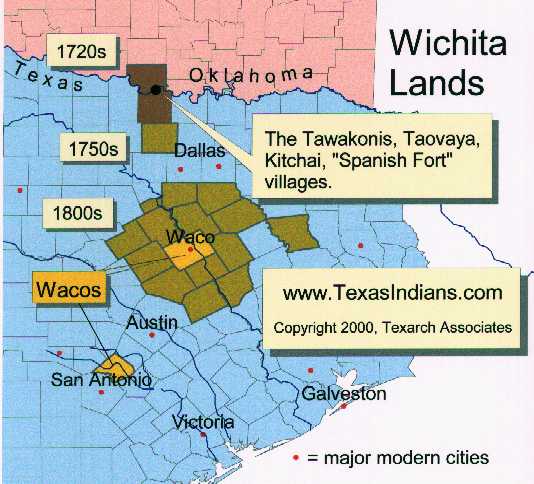
The Wichita were troublesome to have as neighbors. Many settlers were upset by their constant begging and stealing and raiding. For example, in 1757 the San Saba Mission was built for the Lipan Apaches on the western edge of the hill country near Llano, Texas. But, before to long, the Comanche and Wichita raided it so often that is was abandoned.
Well, with all this raiding and stealing, you can imagine why by 1854 the Texans (Texas was now part of the United States) were so upset with the Indians that they decided to put them on reservations where they could be better controlled. The Wichita, along with some Comanche and others, were moved to a reservation on the Brazos River called Clear Fork. By this time the Wichita had become desperate. Their people had been hit hard by a smallpox epidemic in 1837. There were not enough of them left to pose a serious threat to settlers. However, they were skilled thieves and raiders and continued to raid the settler s horses and cattle. In 1859 the Texans had enough of this behavior. They also wanted the land that the Brazos Reservation was on. So, several Indian Agents got together and moved the Wichita out of Texas into Indian Territory. Do you know where Indian Territory is? Well, it started out being a rather unclear area in the western United States. By 1834, this area had been reduced to include only the land that now makes up the states of Kansas, Nebraska, North and South Dakota, and Oklahoma. When Kansas and Nebraska became territories in 1854, this area was reduced again and now only included Oklahoma. After Oklahoma became a state in 1907, the Indian Territory was absorbed into the new state. So, from 1830 to 1907, the Indians watched their territory shrink to the size of a few reservations. That s only 77 years, guys. One lifetime. Have you ever wondered how much change will occur in your lifetime? Anyway, the Wichita ended up on a reservation near Fort Cobb in Oklahoma. Fort Cobb is near Anadarko which is southwest of Oklahoma City. Can you find it on a map? The Wichita are still concentrated on reservations in Oklahoma today.
Here is a Wichita myth. Thanks to Jane Archer and Wordware Publishing for sharing it with us.
Coyote Challenges Never-Grows-Larger
from Texas Indian Myths and Legends
by Jane Archer
One time Ketox, or Coyote, bounded across the prairie and saw Never-Grows-Larger, the smallest snake, sunning on a large, flat rock. "You are tiny," Coyote said. "I would never want to be as little as you. Look at me. You should be as big as me." Never-Grows-Larger looked Coyote up and down, then flicked a long, forked tongue out and in. "Let me see your teeth," Coyote said. Never-Grows-Larger opened wide to reveal tiny teeth. "Look at my teeth." Coyote snarled to reveal big, sharp teeth. "With no effort at all I could bite you in two." Never-Grows-Larger flicked a long tongue out and in again. "Let us bite each other and see who is more powerful," Coyote said. "Are you sure?" Never-Grows-Larger asked. "Yes." "I accept the challenge." Coyote bit hard enough to almost sever Never-Grows-Larger's head. Never-Grows-Larger bit Coyote. "Now I will go just out of sight, then we will call to each other to see how the other fares." Coyote bounded through the tall grass and lay down out of sight. "Hey!" "Hey," Never-Grows-Larger called faintly. "Hey!" "Hey," Never-Grows-Larger said even more weakly. Pleased with success, Coyote repeatedly called and listened to Never-Grows-Larger's voice grow soft. "I never doubted I would kill that snake," Coyote whispered. After a time, Coyote noticed that the snakebite swelled, and the wound started to hurt. "Hey." But the sound was not as loud. Soon Coyote's entire body hurt and swelled up. "Hey!" Never-Grows-Larger called loud and clear. "Hey," Coyote said softly. "Hey!" Never-Grows-Larger called again. Coyote did not respond. Never-Grows-Larger crawled through the grass to Coyote's side. The animal lay dead. Never-Grows-Larger left Coyote there, then went back to sunning on the rock.
Copyright, 2000, Jane Archer
If you enjoyed this myth, read more in Texas Indian Myths and Legends by Jane Archer. You can order a copy here at our e-Book store, or ask your librarian to order Texas Indian Myths and Legends for your school.
Did you like that myth? To learn more about Indian myths and for activities using myths check out our Indian Myths page.
There are not very many Wichita left today. But there used to be many of them. We are not sure how many there were when Coronado first found them, but he said their were 25 towns. We don t know how many houses were in each town, but we do know that each house had 10 to 12 beds in it. By 1772, Indian population numbers were being recorded. The Wichita had about 600 warriors (not counting non-warriors, women or children) at that time. In 1780, it was estimated that there were about 3,200 total Wichita. By 1805, a number of 400 men was given and by 1868, the population is recorded as being 572 total Wichita, including the subtribes. Finally, in the census of 1937, we see that there were only 385 left. Wow, its kinda scary to think that a population could be reduced so quickly. What if that happened to your people?
Nowadays, the Wichita children have to go to school just like you. They wear the same kind of clothes as you do. Some of them will go to college when they finish high school and become doctors or lawyers or computer scientists, just like some of you will. Their parents have jobs just like your parents do. However, they also have to remember that they are Wichita. They have to learn how to do all the special things that the Wichita do. If you ever get up to Oklahoma, perhaps you will stop in and see them. You could tell them how much you have learned about their culture.